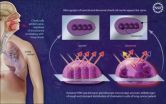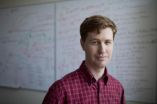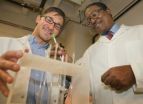(Press-News.org) Early detection is critical for improving cancer survival rates. Yet, one of the deadliest cancers in the United States, lung cancer, is notoriously difficult to detect in its early stages.
Now, researchers have developed a method to detect lung cancer by merely shining diffuse light on cells swabbed from patients' cheeks.
In a new clinical study, the analysis technique--called partial wave spectroscopic (PWS) microscopy--was able to differentiate individuals with lung cancer from those without, even if the non-cancerous patients had been lifetime smokers or suffered from chronic obstructive pulmonary disease (COPD).
The findings-released by a team of engineers and physicians from NorthShore University Health System, Northwestern University and New York University-appear in print in the Oct. 15, 2010, issue of the journal Cancer Research.
"This study is important because it provides the proof of concept that a minimally intrusive, risk-stratification technique may allow us to tailor screening for lung cancer, the leading cause of cancer deaths in Americans," said physician and researcher Hemant Roy of NorthShore University HealthSystems and the University of Chicago, the lead author on the paper. "This represents a major step forward in translating biomedical optics breakthroughs for personalized screening for lung cancer."
The recent results are an extension of several successful trials involving the light-scattering analysis technique, including early detection successes with pancreatic cancer and colon cancer. NSF has supported the team's work since 2002, with an early grant to Roy's collaborator and co-author, bioengineer Vadim Backman of Northwestern University.
"Their work has now transitioned to a larger $2 million Emerging Frontiers in Research and Innovation award," said Leon Esterowitz, a biophotonics expert and program director at NSF who has long supported the research. "The results have even larger implications in that the techniques and the 'field effect' may be a general phenomena that could be applied to a multitude of epithelial cancers, the most common cancer type."
The continuing clinical and laboratory experiments involving the PWS light-scattering technique-and its predecessor technologies, four-dimensional elastic light scattering fingerprinting (4D-ELF) and low-coherence enhanced backscattering spectroscopy (LEBS)-are revealing new information about the changes cells undergo when cancer emerges somewhere in the body.
Within affected cells, including otherwise healthy cells far from an actual tumor, the molecules in the nucleus and cellular skeleton appear to change. On the scale of roughly 200 nanometers or less, even to the scale of molecules, an affected cell's structure becomes so distorted that light scatters through the cell in a telling way.
The ability of cancer to cause changes in distant, healthy tissue is called the "field effect" or "field of injury" effect, and is the physical mechanism that allows cells in the cheek to reveal changes triggered by a tumor far off in a patient's lung.
"Microscopic histology and cytology have been a staple of clinical diagnostics detecting micro-scale alterations in cell structure," added Backman. "However, the resolution of conventional microscopy is limited. PWS-based nanocytology, on the other hand, detects cellular alterations at the nanoscale in otherwise microscopically normal-appearing cells."
"What is intriguing is that the very same nanoscale alterations seem to develop early in very different types of cancer including lung, colon and pancreatic cancers," Backman continued. "Not only does this suggest that nanocytology has the potential to become a general platform for cancer screening, but also that these nanoscale alterations are a ubiquitous event in early carcinogenesis with critical consequences for cell function. Elucidating the mechanisms of these alterations will help us understand the initial stages of carcinogenesis and improve screening."
INFORMATION:
This research was supported by the National Science Foundation through ten individual grants over the last decade, including CBET-0939778 and CBET-0937987.
Read more about the work in the Northwestern University press release.
Media Contacts
Joshua A. Chamot, NSF (703) 292-7730 jchamot@nsf.gov
Megan Fellman, Northwestern University (847) 491-3115 fellman@northwestern.edu
Jim Anthony, NorthShore University HealthSystem (847) 570-6132 janthony@northshore.org
Program Contacts
Sohi Rastegar, NSF (703) 292-8305 srastega@nsf.gov
Leon Esterowitz, NSF (703) 292-7942 lesterow@nsf.gov
Principal Investigators
Vadim Backman, Northwestern University (847) 467-4010 v-backman@northwestern.edu
Co-Investigators
Hemant Roy, NorthShore University HealthSystems and the University of Chicago h-roy@northwestern.edu
Cheek swab may detect lung cancer
In clinical trial, technique appears to detect lung cancer far afield from a tumor
2010-10-08
ELSE PRESS RELEASES FROM THIS DATE:
Water discovered on second asteroid, may be even more common
2010-10-08
Water ice on asteroids may be more common than expected, according to a new study that will be presented today at the world's largest gathering of planetary scientists.
Two teams of researchers who made national headlines in April for showing the first evidence of water ice and organic molecules on an asteroid have now discovered that asteroid 65 Cybele contains the same material.
"This discovery suggests that this region of our solar system contains more water ice than anticipated," said University of Central Florida Professor Humberto Campins. "And it supports the ...
Childhood adversity may lead to unhealthy stress response in adult life
2010-10-08
PROVIDENCE, R.I. [Brown University] — Seemingly healthy adults, if they were abused or neglected during childhood, may suffer physiological consequences decades later. In research published online last week by the journal Neuropsychopharmacology, a team led by psychiatrists at Brown University and Butler Hospital found that healthy adults who reported being mistreated as kids appear to have an elevated inflammatory response to stress compared to adults who had happier childhoods.
Lead author Linda Carpenter, associate professor of psychiatry and human behavior, said that ...
New study shows benefits of Bt corn to farmers
2010-10-08
A group of agricultural scientists reported in today's issue of the journal Science that corn that has been genetically engineered to produce insect-killing proteins isolated from the soil bacterium Bacillus thuringiensis (Bt) provides significant economic benefits even to neighboring farmers who grow non-transgenic varieties of corn.
"Modern agricultural science is playing a critical role in addressing many of the toughest issues facing American agriculture today, including pest management and productivity," said Agriculture Secretary Tom Vilsack. "This study provides ...
Stem cells shape up to their surroundings
2010-10-08
London, UK (October, 07, 2010) –Many scientists aspire to take control over the stem cell differentiation process, so that we can grow organs and implants perfectly matched to each patient in the future. Now research in the Journal of Tissue Engineering, published by SAGE-Hindawi, explains how engineering the topography on which stem cells grow, and the mechanical forces working on them, can be as powerful an agent for change as their chemical environment.
Stem cells respond to the stiffness, chemistry and topography of the environments they find themselves in – and scientists ...
Election forecasts favor Republican gains in midterm
2010-10-08
WASHINGTON, DC-In the weeks leading up to the 2010 midterm elections, five forecasters or teams of forecasters offer models and predictions for the House in the most recent issue (October 2010) of PS: Political Science and Politics, a journal of the American Political Science Association. The models offer a broad consensus that the Republicans will make substantial gains in the House, although there is not a consensus over how large those gains will be. A 30-seat spread between the low and high end of the seat change forecast range exists, with two forecasters giving an ...
Structure of plastic solar cells impedes their efficiency
2010-10-08
A team of researchers from North Carolina State University and the U.K. has found that the low rate of energy conversion in all-polymer solar-cell technology is caused by the structure of the solar cells themselves. They hope that their findings will lead to the creation of more efficient solar cells.
Polymeric solar cells are made of thin layers of interpenetrating structures from two different conducting plastics and are increasingly popular because they are both potentially cheaper to make than those currently in use and can be "painted" or printed onto a variety ...
Stanford-led study disproves link between genetic variant, risk of coronary artery disease
2010-10-08
STANFORD, Calif. — A genetic marker touted as a predictor of coronary artery disease is no such thing, according to a study led by researchers at the Stanford University School of Medicine.
The massive international study, published online Oct. 7 in the Journal of the American College of Cardiology, assessed the predictive value of a leading genetic assay for risk of atherosclerosis.
The study analyzed the data from more than 17,000 patients with cardiovascular disease and 40,000 others to assess whether carrying a particular variant of the KIF6 gene indicated a greater ...
New tool in the fight against tuberculosis
2010-10-08
Researchers at the Institute for Genomic Biology at the University of Illinois have developed a way to harness the prodigious quantities of both genomic and metabolic data being generated with high-throughput genomics and other techniques. They have developed an algorithm that automatically integrates both data sets. The model, called probabilistic regulation of metabolism (PROM), enables researchers to perturb a given regulatory gene or metabolic process and see how that affects the entire network.
"PROM provides a platform for studying the behavior of networks in a ...
Thoughts about time inspire people to socialize
2010-10-08
Does thinking about time or money make you happier? A new study published in Psychological Science, a journal of the Association for Psychological Science, finds that people who are made to think about time plan to spend more of their time with the people in their lives while people who think about money fill their schedules with work, work, and—you guessed it—more work.
To find out how thinking about time or money makes people feel, Cassie Mogilner of the University of Pennsylvania designed an experiment, carried out online with adults from all over the United States, ...
Brown University chemists simplify biodiesel conversion
2010-10-08
PROVIDENCE, R.I. [Brown University] — As the United States seeks to lessen its reliance on foreign oil, biodiesel is expected to play a role. According to the National Renewable Energy Laboratory, a branch of the Department of Energy, biodiesel "represents a significant energy resource and could someday supply 3 percent to 5 percent of the distillate fuel market."
One major obstacle to achieving that goal is figuring how to efficiently convert the abundant stocks of waste vegetable oil (oil used after cooking French fries, for example) into biodiesel fuel. Current techniques ...
LAST 30 PRESS RELEASES:
Securing AI systems against growing cybersecurity threats
Longest observation of an active solar region
Why nail-biting, procrastination and other self-sabotaging behaviors are rooted in survival instincts
Regional variations in mechanical properties of porcine leptomeninges
Artificial empathy in therapy and healthcare: advancements in interpersonal interaction technologies
Why some brains switch gears more efficiently than others
UVA’s Jundong Li wins ICDM’S 2025 Tao Li Award for data mining, machine learning
UVA’s low-power, high-performance computer power player Mircea Stan earns National Academy of Inventors fellowship
Not playing by the rules: USU researcher explores filamentous algae dynamics in rivers
Do our body clocks influence our risk of dementia?
Anthropologists offer new evidence of bipedalism in long-debated fossil discovery
Safer receipt paper from wood
Dosage-sensitive genes suggest no whole-genome duplications in ancestral angiosperm
First ancient human herpesvirus genomes document their deep history with humans
Why Some Bacteria Survive Antibiotics and How to Stop Them - New study reveals that bacteria can survive antibiotic treatment through two fundamentally different “shutdown modes”
UCLA study links scar healing to dangerous placenta condition
CHANGE-seq-BE finds off-target changes in the genome from base editors
The Journal of Nuclear Medicine Ahead-of-Print Tip Sheet: January 2, 2026
Delayed or absent first dose of measles, mumps, and rubella vaccination
Trends in US preterm birth rates by household income and race and ethnicity
Study identifies potential biomarker linked to progression and brain inflammation in multiple sclerosis
Many mothers in Norway do not show up for postnatal check-ups
Researchers want to find out why quick clay is so unstable
Superradiant spins show teamwork at the quantum scale
Cleveland Clinic Research links tumor bacteria to immunotherapy resistance in head and neck cancer
First Editorial of 2026: Resisting AI slop
Joint ground- and space-based observations reveal Saturn-mass rogue planet
Inheritable genetic variant offers protection against blood cancer risk and progression
Pigs settled Pacific islands alongside early human voyagers
A Coral reef’s daily pulse reshapes microbes in surrounding waters
[Press-News.org] Cheek swab may detect lung cancerIn clinical trial, technique appears to detect lung cancer far afield from a tumor



